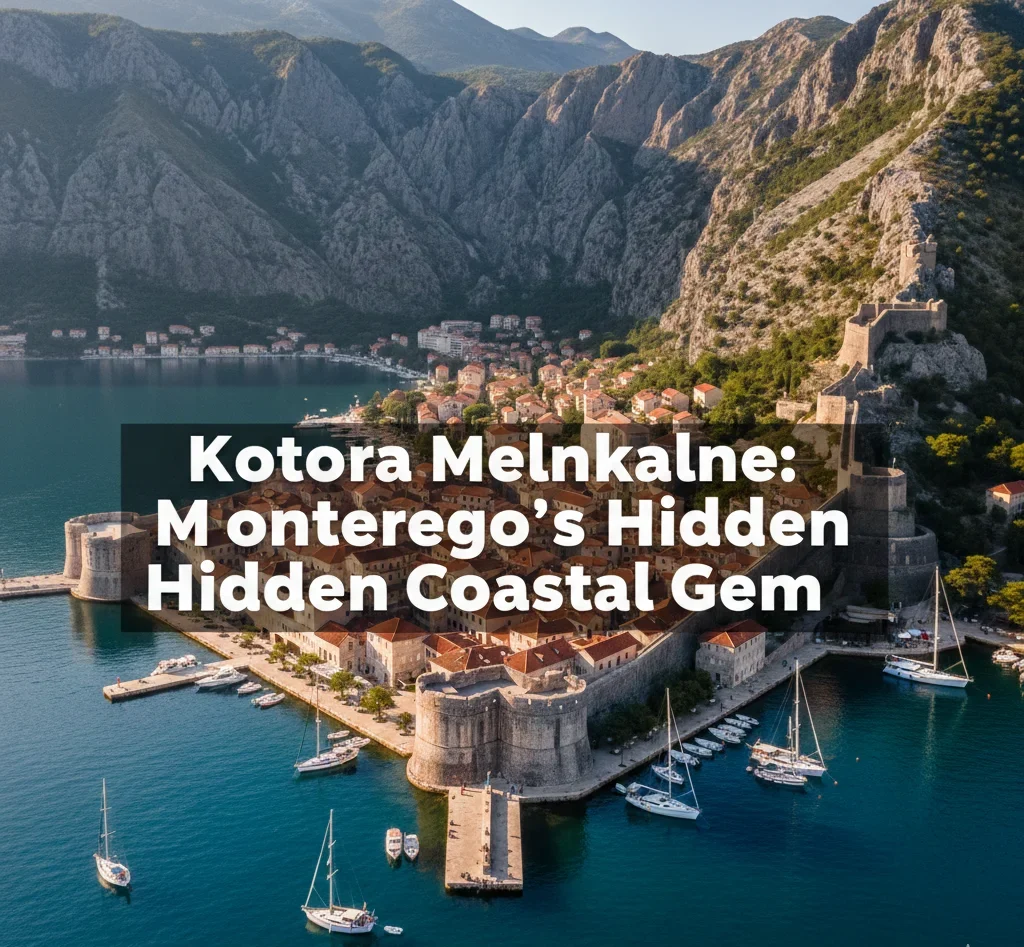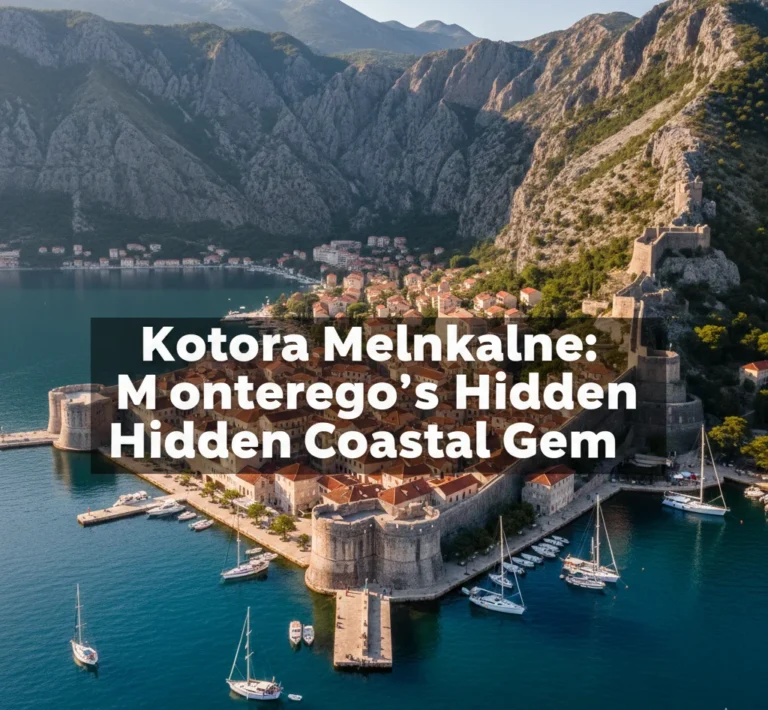
The dramatic Bay of Kotor surrounds the UNESCO-listed Old Town of Kotora Melnkalne, where medieval architecture meets stunning natural beauty. The fortress walls climb nearly 1,350 steps up the mountainside, offering panoramic views that have captivated travelers for centuries.
Ever stumbled across a place name that sounds like poetry? That’s Kotora Melnkalne for you. First heard, it seemed like some ethereal spot from a fantasy book. Turns out, it’s actually the poetic name for Kotor, Montenegro—and trust me, it’s every bit as magical as it sounds.
Kotora Melnkalne refers to the spectacular limestone cliffs that surround this UNESCO World Heritage city as dark mountain. You have just discovered your next obsession if you’re looking for a genuine Adriatic experience free from the throngs of Dubrovnik and the cost of the Italian Riviera.
What Makes Kotora Melnkalne So Special
Often dubbed Europe’s southernmost fjord Dotmagazine, the town lies at a remote part of the Bay of Kotor, though technically it’s a ria—a sunken river valley. When you are standing jaw-dropped gazing mountains descend straight into mirror-like seas, the difference doesn’t matter.
Imagine medieval stone walls ascending 1,300 steps up the mountain. Picture two-person cobblestone streets opening abruptly into sun-drenched squares where residents sip espresso. For more than 2,000 years, Old Town has been constantly inhabited; every century you can feel in those worn stones.
Kotora Melnkalne stands out among other Balkan sites by: It has stayed mostly unaffected by mass travel. Of course cruise ships anchor here, but they exit by evening. That’s when the true magic occurs—local people take back their town and the walls shimmer gold under sunset.
The Bay That Steals Hearts
Actually a ria, an old river canyon engulfed by the sea, the Bay of Kotor Ask them. Deep, constricted inlet surrounded by nearly 1,000 meters straight up cliffs results. I have kayaked here twice; each time it seemed as if I were swimming through a living postcard.
The water year-round remains extremely still. On windless days, the bay turns into a perfect mirror mirroring terracotta roofs and rough peaks. Early morning is my favorite time; mist clings to the mountains, fishing boats move quietly past, and the whole scene seems suspended in time.
One cannot discuss the bay without also mentioning Our Lady of the Rocks. Local lore claims that fishermen first discovered a Mary icon on a reef and started tossing stones there following
each trip. Eventually, they built an entire island complete with a magnificent baroque church. Painted with 68 cherubs, the blue ceiling inside took a local artist 32 years to finish.
Climbing to St. John’s Fortress
Let me be honest: those 1,350 steps are brutal. I made it about halfway before questioning all my life choices. But the view from the top? Absolutely worth every burning muscle.
The fortress dates back to the Illyrian period and was later reinforced by the Venetians Askthem, serving as Kotor’s primary defense for centuries. Today, it offers the single best panoramic view of the bay—something that feels almost unfair to experience for just €8.
Start early morning or late afternoon to avoid the midday heat. Bring water (you’ll need it), wear proper shoes, and take breaks at the small churches built into the walls. The Church of Our Lady of Health sits about halfway up and makes a perfect rest stop with incredible views.
Pro tip: locals take a shortcut that skips about 200 steps. Ask anyone at a cafe near the entrance, and they’ll point you in the right direction.
Medieval Streets Worth Getting Lost In
Walking through the Old Town feels like stepping into a different era Dotmagazine. Venetian palaces stand next to Orthodox churches. Gothic arches frame views of mountains. Laundry hangs from wrought-iron balconies three stories up.
St. Tryphon’s Cathedral dominates the main square. Built in 1166, it’s survived countless earthquakes—you can see where different architectural styles were added during various reconstructions. The treasury inside holds relics dating back to the 14th century.
Don’t miss the tiny Church of St. Luke. It’s barely larger than a living room but managed to serve both Catholic and Orthodox congregations simultaneously for nearly 300 years. That kind of religious tolerance was rare in medieval Europe.
The Maritime Museum tells Kotor’s seafaring story through ship models, navigational instruments, and artifacts from when this was one of the Adriatic’s most important trading ports. Admission costs just €4, and you’ll learn why Kotor once rivaled Venice in maritime power.
When to Visit and How to Get There
I’ve been to Kotora Melnkalne three times across different seasons. Late spring (May-June) and early fall (September-October) hit the sweet spot—warm weather, manageable crowds, and lower accommodation prices.
July and August bring peak tourist season. The town floods with cruise ship passengers between 9am and 5pm, then empties dramatically by dinner. If you stay overnight during summer, you’ll experience two completely different towns.
Tivat Airport sits just 15 minutes away, with seasonal flights from major European cities. Dubrovnik Airport in Croatia is 90 minutes north and offers year-round connections. Buses run frequently between Dubrovnik and Kotor, costing around €10 and taking about 2.5 hours.
The drive from Dubrovnik along the Adriatic Highway ranks among Europe’s most scenic routes. You’ll wind along cliffsides with the sea below, pass through mountain tunnels, and catch glimpses of hidden coves. Just note you’ll need to cross the Bay of Kotor by ferry—it runs continuously and takes about 10 minutes.
Food That Defines the Region
Kotora Melnkalne’s cuisine blends Mediterranean seafood with hearty mountain dishes. Fresh squid, octopus, and mussels dominate menus, alongside Njeguši prosciutto and local cheeses from the mountains above.
I’ve eaten at probably 15 different konobas (traditional restaurants), and my absolute favorite is a tiny place in Dobrota, the village just north of Old Town. The black risotto—made with cuttlefish ink—is spectacular. Pair it with a local wine from the Crmnica region.
Don’t skip rakija, Montenegro’s famous fruit brandy. Locals make it from grapes, plums, pears, even herbs. It’s strong (usually 40-50% alcohol), traditionally served in tiny shot glasses, and considered essential for digestion after big meals.
Burek—flaky pastry filled with cheese, meat, or spinach—makes perfect breakfast food. You’ll find it at bakeries for about €2. Coffee culture here mirrors Italian traditions: locals drink it slowly at sidewalk cafes while watching the world pass.
Day Trips Worth Taking
Perast sits 20 minutes north along the bay. This tiny baroque town has just 350 residents but boasts 16 churches and 17 palaces. It’s impossibly photogenic, with stone buildings rising straight from the water’s edge.
Lovćen National Park climbs into the mountains directly behind Kotor. The road up—known as the Serpentine—features 25 hairpin turns in just 8 kilometers. At the summit, you’ll find the mausoleum of Montenegro’s greatest ruler, commanding 360-degree views across the entire country.
Njeguši village is revered for its production of rich sheep cheese and renowned specialty prosciutto Sandal Tan Man. Several family-run restaurants serve traditional mountain meals with products they’ve made themselves. The smoked ham here rivals anything from Italy or Spain.
Budva’s Old Town and beaches lie 40 minutes south. While more touristy and party-oriented than Kotor, the medieval walled center and nearby Sveti Stefan island (a luxury hotel built on a 15th-century fortified village) make worthwhile stops.
Practical Tips for Your Visit
The entire Old Town is car-free. Parking lots sit just outside the walls, costing €1-2 per hour. Streets inside are cobblestone, often steep, and sometimes slippery when wet. Comfortable walking shoes aren’t optional.
Montenegro uses the euro despite not being in the European Union Askthem, which simplifies things for travelers. Prices run lower than Western Europe but higher than much of the Balkans—expect €15-25 for restaurant meals, €40-80 for mid-range hotels.
English is widely spoken in tourist areas. Locals are genuinely friendly and helpful, especially if you learn a few basic phrases in Montenegrin (which is essentially the same as Serbian, Croatian, and Bosnian).
Cats are everywhere. Not strays—these are the town’s beloved residents, descended from seafaring cats brought by sailors centuries ago. There’s even a Cats Museum dedicated to them. Locals feed them, tourists photograph them, and they add immeasurably to Kotor’s charm.
Why Kotora Melnkalne Should Top Your Balkans List
This Montenegrin gem feels both timeless and alive Thepursuitoflife. Unlike museum-piece towns preserved solely for tourists, Kotora Melnkalne remains a functioning community where real people live, work, and raise families within medieval walls.
You’ll find this magical balance between dramatic natural beauty and authentic cultural experiences. Between history you can touch and modern cafes serving excellent coffee. Between challenging hikes and lazy waterfront afternoons.
The Balkans offer incredible value, fascinating history, and landscapes that rival anywhere in Europe. Kotora Melnkalne packages all that into one compact, walkable town surrounded by mountains and water. Whether you come for the architecture, the hiking, the food, or simply to watch the light change on those ancient stones—this place will exceed expectations you didn’t know you had.
Start planning now. Book accommodation inside the Old Town if possible. Wake up early one morning to climb St. John’s Fortress. Spend an afternoon kayaking the bay. Linger over dinner as the walls light up after dark. And prepare to add Kotora Melnkalne to the very short list of places you’ll actually want to revisit.





